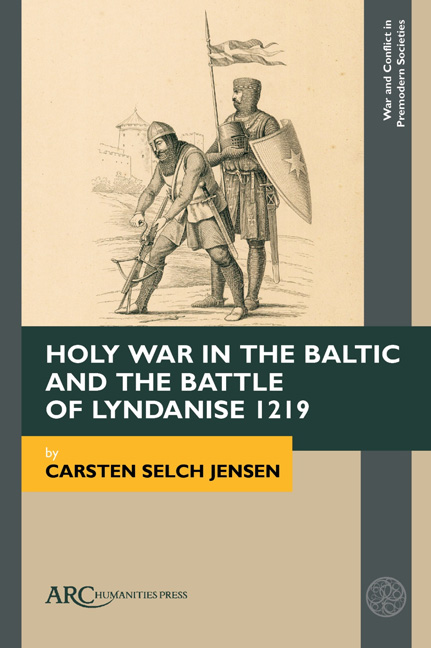Book contents
- Frontmatter
- Contents
- List of Illustrations
- Acknowledgments
- Introduction. Holy War in the Baltic and the Battle of Lyndanise 1219
- Chapter 1 Foreign Shores—Foreign People: The Medieval Baltic and its People
- Chapter 2 Fighting God’s War: Papal Crusading Politics in the Baltic from the Early 1100s until the Early 1200s
- Chapter 3 A Society Organized for War: Denmark at the Beginning of the Thirteenth Century
- Chapter 4 Competing Powers: The German Mission in Livonia and the Initial Quest for Estonia
- Chapter 5 Waging War in the Wilderness: Western Military Traditions Meet Baltic Traditions
- Chapter 6 The Danish Expedition to Estonia in 1219 and the Battle of Lyndanise
- Chapter 7 Conquering Hearts and Minds: The Aftermath of the Battle
- Conclusion A Penny in the Box: How Estonia Came to Save Denmark
- Select Bibliography
- Index
Chapter 6 - The Danish Expedition to Estonia in 1219 and the Battle of Lyndanise
Published online by Cambridge University Press: 08 May 2024
- Frontmatter
- Contents
- List of Illustrations
- Acknowledgments
- Introduction. Holy War in the Baltic and the Battle of Lyndanise 1219
- Chapter 1 Foreign Shores—Foreign People: The Medieval Baltic and its People
- Chapter 2 Fighting God’s War: Papal Crusading Politics in the Baltic from the Early 1100s until the Early 1200s
- Chapter 3 A Society Organized for War: Denmark at the Beginning of the Thirteenth Century
- Chapter 4 Competing Powers: The German Mission in Livonia and the Initial Quest for Estonia
- Chapter 5 Waging War in the Wilderness: Western Military Traditions Meet Baltic Traditions
- Chapter 6 The Danish Expedition to Estonia in 1219 and the Battle of Lyndanise
- Chapter 7 Conquering Hearts and Minds: The Aftermath of the Battle
- Conclusion A Penny in the Box: How Estonia Came to Save Denmark
- Select Bibliography
- Index
Summary
ACCORDING TO HENRY of Livonia, the preparations for the Danish attack on Lyndanise had begun in the summer of 1218 when King Valdemar II summoned all important men of his realm for a meeting in Schleswig. Among the participants were fifteen bishops, three dukes, and three counts, together with an unsaid number of abbots and other worthy people. The alleged primary reason for the summoning of all these important individuals was the king's wish to have his eldest son and heir, Prince Valdemar, crowned in the cathedral church of Schleswig. The young prince had already been recognized as heir to the throne in 1215 and it was time to have him wear the crown like his father, thereby consolidating the order of succession. In this way, King Valdemar II followed in the footsteps of his father, King Valdemar I who was the first king of Denmark to have his son, the future King Knud VI, crowned as co-regent in 1170, while at the same having his father Knud Lavard enshrined fol-lowing his recognition as a saint the previous year by the pope. Now King Valdemar II followed in his father's footsteps and had his own oldest son crowned as his co regent. The cathedral church of Schleswig must have seemed the ideal place for this important dynastic event for several reasons. It was the main town of the duchy of Southern Jylland and also conveniently located with regards to King Valdemar's involvement in the (imperial) politics of northern Germany and his many military campaigns there.
Among the high number of bishops mentioned in the sources was also probably Bishop Albert of Riga. Henry of Livonia mentions that the German bishop went to see King Valdemar, accompanied by a former German knight, Bernhard of Lippe (ca. 1140–1224), who had become abbot of the Cistercian monastery of Mount St. Nicholas (Daugavgrīva/Dünamünde) not far from Riga. Later that same year Bernhard became bishop of Semgallia and was thus closely tied to the politics of the Livonian Church. Henry also mentions that “the bishop of Estonia” (episcopus…Estiensis) accompanied Bishop Albert to this meeting in Schleswig. It cannot have been anyone else but Bishop Theodoric who would eventually follow King Valdemar on the expedition to Estonia the following year.
- Type
- Chapter
- Information
- Holy War in the Baltic and the Battle of Lyndanise 1219 , pp. 103 - 118Publisher: Amsterdam University PressPrint publication year: 2024



